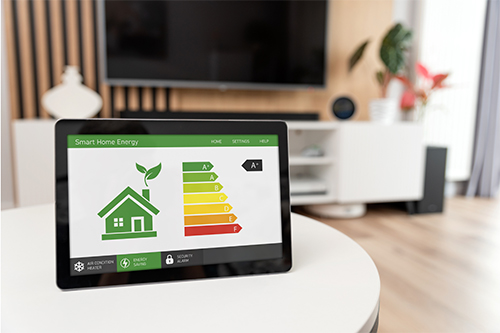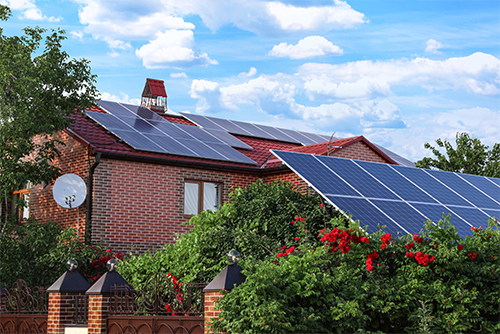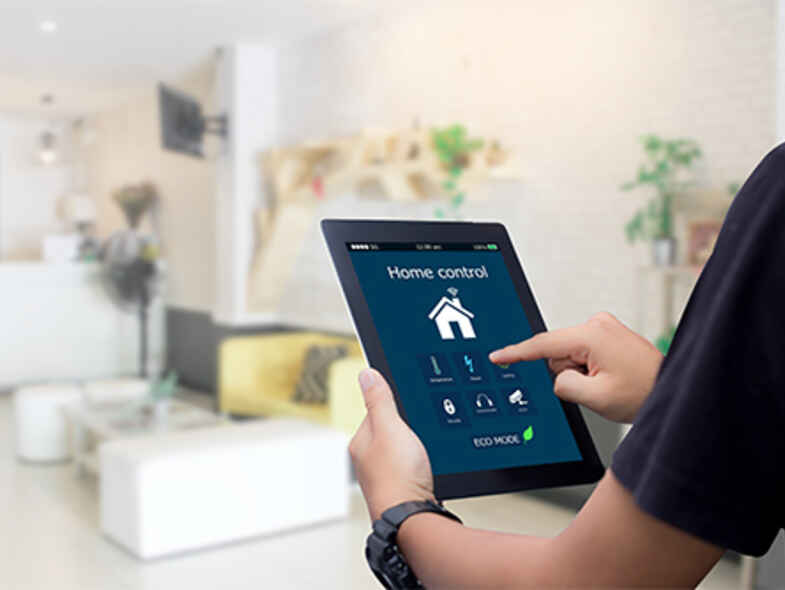Photography by Getty Images
Whether it’s switching to solar energy, installing smart technology, or learning how to design and build an eco-friendly home, there’s so much you can start doing right away to reduce your property’s footprint. Here’s our guide to carbon-conscious living in the ACT.
Smart Technology
The term ‘smart home’ describes a home that uses technology to monitor, control and connect appliances, devices and electronics remotely using a web-enabled device. Using smart technology at home might not only make life more convenient and more secure, but it can also help you lead a more environmentally conscious lifestyle and reduce your home’s energy bill. For example, blinds can be programed to close during the hottest or coolest parts of the day to either keep the home warm or cool, depending on the season. Smart technology can also turn off a light that was accidentally left on, or for something even more advanced – a garden watering system that checks the weather forecast and automatically adjusts its schedule when rain is detected.
Green Star
The Green Building Council of Australia has developed the Green Star standard for homes – a home that is designed to be comfortable, healthy and doesn’t cost the earth to run. To be a Green Star home, it must meet standards in three categories, each of which the council says plays an essential role to ensure homes are better, not just for today but for tomorrow. The three standards are:
- Positive: Fully electric, draught sealed, efficient, and powered by renewables;
- Healthy: Ventilated, comfortable and with products that are better for you; and
- Resilient: Water efficient and climate change ready.
Home builders such as Ingenia, Stockland, Mirvac, Metricon and Landcom build a range of Green Star homes, but if you already own or occupy your own home, there are three ways it can be made even better. Firstly, reduce air loss by improving your insulation. Secondly, install solar panels. And finally, go all electric. According to the council, Green Star homeowners may be financially better off from day one, with savings in energy costs of $90-$140 a month. More information about the Green Star standard can be found at gbca.org.au.

Photography by Proxima Studio
ECO-FRIENDLY NEIGHBOURHOODS
As we continue to see many new housing developments emerge around the capital, one community in Canberra’s north west is doing things differently. Ginninderry, which spans the ACT and NSW borders, was purposely planned to raise the bar for best practices in sustainability, design, construction and innovation. Ginninderry is attracting national and international attention for setting a new benchmark in the development of a highly liveable, sustainable community, and has even been named Canberra’s first Green Star Communities 6-Star rated development. The vision for the Ginninderry housing project was to:
- employ practices, processes and systems that embody innovation and design excellence;
- be sustainable over time, socially, economically and ecologically (with a low and reducing ecological footprint);
- respond to the local and global environment;
- provide for future beneficial change to occur in design, infrastructure and regulatory mechanisms;
- be cost effective, replicable and measurable; and
- act as a new model that others can follow.
In the next 30 years, around 30,000 people will one day call the area and its four suburbs home – its plan is for the community to grow at the rate of three or four hundred homes a year, to an eventual total of 11,500 homes. To learn more about the community and how it is inspiring a new way of living, visit ginninderry.com.

Photography by Africa Images
Solar Power
In 2018, the ACT Government announced a target to reduce greenhouse gas emissions by 100% (net zero emissions) by 2045 and one of the many ways homeowners can work towards this target is by installing rooftop solar panels. In fact, more than 39,000 households and businesses in the ACT currently have solar panels and the number is growing every year. Solar is an extremely effective way to save energy without costing the earth. According to Solar Choice, in Canberra a typical 6kw solar system costs $5,850 including GST on average after deducting the STC rebate. While the installation cost isn’t a small outlay of money, over the long term this one-time purchase can save you thousands on future power bills, as well as add value to your home.
Passivhaus
If you’re planning to build a new home, then have you considered the Passive House (Passivhaus) approach? The concept originated in Europe in the 1990s and is a voluntary, global standard that focuses on creating healthier, more energy efficient, and more comfortable homes and commercial spaces. The term ‘passive’ comes from the building relying on external and natural influences – such as shade, sun and ventilation. Each element is carefully considered in the design and tailored to the local climate and property’s surroundings. A Passive House design aims to reduce building energy use by 80-90% and keep the inside temperature in a comfortable range between 20-25°C without the need for heating and cooling systems. The design and construction principles are based on science and can be applied to buildings in any climate, giving you ultimate control of your environment and reducing your carbon footprint. For more information about the Passive House approach, visit passivhausassociation.com.au
Enjoy this complimentary magazine, become inspired and find endless possibilities for your own inspired living.
To read the e-brochure click here.





